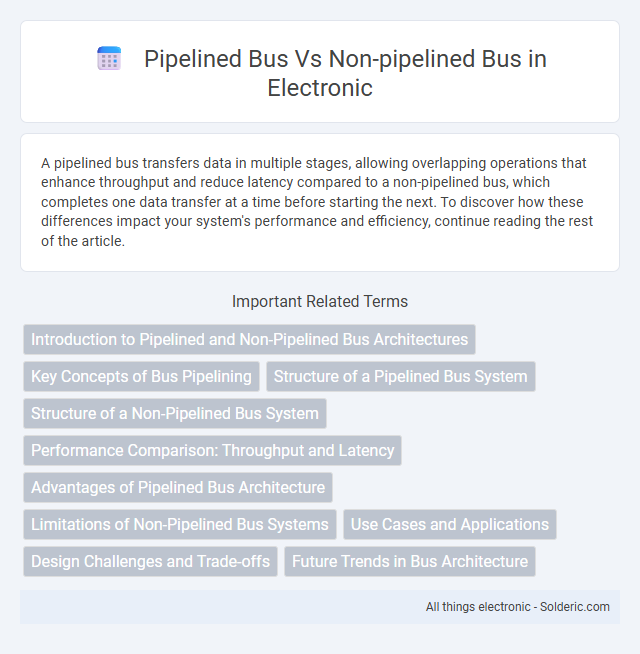A pipelined bus transfers data in multiple stages, allowing overlapping operations that enhance throughput and reduce latency compared to a non-pipelined bus, which completes one data transfer at a time before starting the next. To discover how these differences impact your system's performance and efficiency, continue reading the rest of the article.
Comparison Table
| Feature | Pipelined Bus | Non-Pipelined Bus |
|---|---|---|
| Data Transfer Efficiency | High; overlaps multiple transactions | Low; handles one transaction at a time |
| Throughput | Increased throughput due to parallel stages | Lower throughput; sequential data flow |
| Latency | Higher initial latency but better sustained performance | Lower initial latency; performance drops under load |
| Complexity | More complex design and control logic | Simpler design and easier to implement |
| Power Consumption | Potentially higher due to complexity | Typically lower power usage |
| Use Cases | High-performance systems requiring fast data throughput | Simple systems with lower speed requirements |
Introduction to Pipelined and Non-Pipelined Bus Architectures
Pipelined bus architectures enhance data transfer efficiency by dividing operations into sequential stages, allowing simultaneous processing of multiple data packets and reducing overall latency. Non-pipelined bus systems process one data transaction at a time, leading to higher idle times and lower throughput under heavy loads. Key performance metrics such as bus utilization, data bandwidth, and cycle time significantly improve in pipelined buses compared to their non-pipelined counterparts.
Key Concepts of Bus Pipelining
Bus pipelining enhances data transfer efficiency by segmenting the bus transaction into multiple stages, allowing overlapping of operations and continuous data flow. In contrast, a non-pipelined bus completes one data transfer cycle before initiating the next, leading to idle periods between transactions. Key concepts of bus pipelining include stage division for concurrent operations, reduced latency through parallel processing, and increased throughput by minimizing bus contention.
Structure of a Pipelined Bus System
A pipelined bus system consists of multiple stages that overlap data transfer processes to increase throughput and reduce latency compared to a non-pipelined bus. Each stage in the pipeline handles specific tasks such as address decoding, data transfer, and acknowledgment, allowing several data transactions to be processed simultaneously. Your system benefits from the structured stages of a pipelined bus by enabling continuous data flow and improved bus efficiency.
Structure of a Non-Pipelined Bus System
A non-pipelined bus system consists of a single communication path where data transfer occurs sequentially, completing one operation before starting another. This structure includes a shared bus line, control logic, and timing circuitry to manage data flow, resulting in longer latency due to idle periods between transfers. The absence of overlapping data phases limits throughput compared to pipelined bus architectures, making non-pipelined buses less efficient for high-speed data communication.
Performance Comparison: Throughput and Latency
Pipelined buses significantly enhance throughput by allowing multiple data transactions to overlap, thus increasing the number of operations completed per clock cycle compared to non-pipelined buses. Non-pipelined buses exhibit higher latency since each data transfer must complete fully before the next begins, causing delays in sequential operations. Your system's performance benefits from pipelining when low latency is critical and throughput demands are high, making it ideal for high-speed data processing environments.
Advantages of Pipelined Bus Architecture
Pipelined bus architecture significantly increases data transfer efficiency by overlapping multiple data transactions, allowing Your system to achieve higher throughput compared to non-pipelined buses. This design reduces wait states and latency by enabling continuous data flow, which enhances overall system performance and responsiveness. Furthermore, the modular nature of pipelined buses improves scalability and supports more complex communication protocols without sacrificing speed.
Limitations of Non-Pipelined Bus Systems
Non-pipelined bus systems face significant limitations in data transfer rates due to their sequential processing nature, causing increased latency and reduced throughput. The inability to overlap multiple data transactions results in inefficient utilization of bus bandwidth and longer communication delays. This static approach limits system performance, especially in high-speed computing environments requiring rapid and continuous data exchanges.
Use Cases and Applications
Pipelined buses are ideal for high-performance computing systems and multimedia devices where continuous data flow minimizes latency and maximizes throughput, such as GPUs and modern CPUs. Non-pipelined buses are common in simpler embedded systems and low-speed peripherals where timing control and low overhead are more critical than data transfer speed. Applications requiring predictable, single-cycle data transfers often rely on non-pipelined buses to ensure simpler timing and control circuitry.
Design Challenges and Trade-offs
Pipelined buses introduce design challenges such as increased complexity in timing control and the need for sophisticated error detection due to overlapping data transfers. Trade-offs include improved data throughput and reduced latency at the cost of higher hardware resource utilization and potential difficulty in debugging. Non-pipelined buses offer simpler design and easier synchronization but suffer from lower data transfer rates and increased idle time between transactions.
Future Trends in Bus Architecture
Future trends in bus architecture emphasize the adoption of pipelined bus designs to enhance data throughput and reduce latency in high-performance computing systems. Pipelined buses enable concurrent data transfer stages, maximizing efficiency compared to non-pipelined buses, which transfer data sequentially and face bottlenecks. Your system's scalability and speed improvements will increasingly rely on these advanced bus architectures as computing demands escalate.
pipelined bus vs non-pipelined bus Infographic

 solderic.com
solderic.com